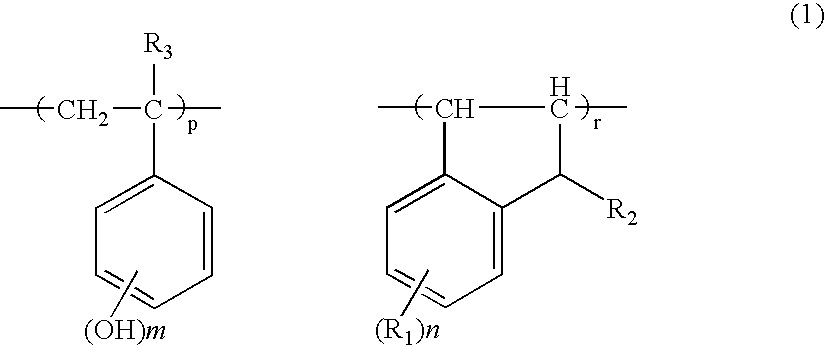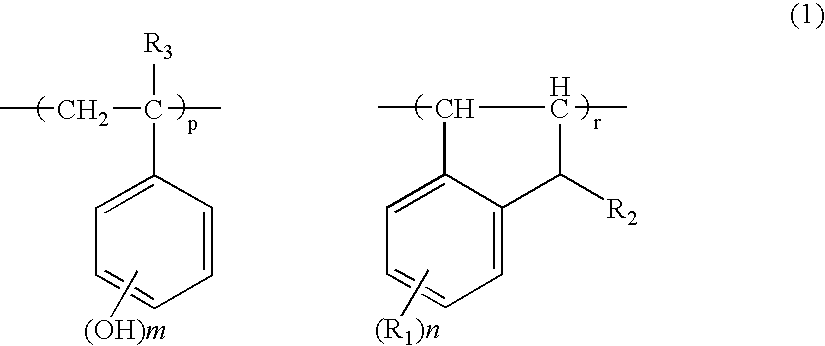Negative resist material and pattern formation method using the same
- Summary
- Abstract
- Description
- Claims
- Application Information
AI Technical Summary
Benefits of technology
Problems solved by technology
Method used
Image
Examples
synthesis example 1
To a 500-mL flask, 96.4 g of acetoxystyrene, 103.6 g of indene and 20 g of toluene as a solvent were added. This reaction vessel was cooled to −70° C. under a nitrogen atmosphere, and degassing under reduced pressure and introduction of a nitrogen flow were repeated three times. After the reaction solution was warmed to room temperature, it was added with 9.8 g of AIBN as a polymerization initiator, warmed to 55° C. and then allowed to react for 25 hours. This reaction solution was concentrated to ½ volume and precipitated in 5.0 L of a methanol solution, and the obtained white solid was taken by filtration and dried under reduced pressure at 40° C. to obtain 111 g of white polymer. This polymer was dissolved again in 0.3 L of methanol and 0.3 L of tetrahydrofuran, added with 70 g of triethylamine and 15 g of water to perform deprotection reaction and neutralized by using acetic acid. The reaction solution was concentrated, then dissolved in 0.5 L of acetone and subjected to precipi...
synthesis example 2
To a 500-mL flask, 126.1 g of acetoxystyrene, 73.9 g of indene and 180 g of toluene as a solvent were added. This reaction vessel was cooled to −70° C. under a nitrogen atmosphere, and degassing under reduced pressure and introduction of a nitrogen flow were repeated three times. After the reaction solution was warmed to room temperature, it was added with 18.6 g of AIBN as a polymerization initiator, warmed to 57° C. and allowed to react for 25 hours. This reaction solution was concentrated to ½ volume and precipitated in 5.0 L of a methanol solution, and the obtained white solid was taken by filtration and dried under reduced pressure at 40° C. to obtain 129 g of white polymer. This polymer was dissolved again in 0.3 L of methanol and 0.3 L of tetrahydrofuran, added with 70 g of triethylamine and 15 g of water to perform deprotection reaction and neutralized by using acetic acid. The reaction solution was concentrated, then dissolved in 0.5 L of acetone and subjected to precipitat...
synthesis example 3
To a 2-L flask, 111.5 g of acetoxystyrene, 58.0 g of indene, 20.3 g of methacrylic acid epoxymethyl ester and 120 g of toluene as a solvent were added. This reaction vessel was cooled to −70° C. under a nitrogen atmosphere, and degassing under reduced pressure and introduction of a nitrogen flow were repeated three times. After the reaction solution was warmed to room temperature, it was added with 9.7 g of AIBN as a polymerization initiator, warmed to 57° C. and then allowed to react for 25 hours. This reaction solution was concentrated to ½ volume and precipitated in a mixed solution of 4.5 L of methanol and 0.5 L of water, and the obtained white solid was taken by filtration and dried under reduced pressure at 60° C. to obtain 135 g of white polymer. This polymer was dissolved again in 0.3 L of methanol and 0.3 L of tetrahydrofuran, added with 70 g of triethylamine and 15 g of water to perform deprotection reaction and neutralized by using acetic acid. The reaction solution was c...
PUM
| Property | Measurement | Unit |
|---|---|---|
| Length | aaaaa | aaaaa |
| Length | aaaaa | aaaaa |
| Length | aaaaa | aaaaa |
Abstract
Description
Claims
Application Information
 Login to View More
Login to View More - R&D
- Intellectual Property
- Life Sciences
- Materials
- Tech Scout
- Unparalleled Data Quality
- Higher Quality Content
- 60% Fewer Hallucinations
Browse by: Latest US Patents, China's latest patents, Technical Efficacy Thesaurus, Application Domain, Technology Topic, Popular Technical Reports.
© 2025 PatSnap. All rights reserved.Legal|Privacy policy|Modern Slavery Act Transparency Statement|Sitemap|About US| Contact US: help@patsnap.com



